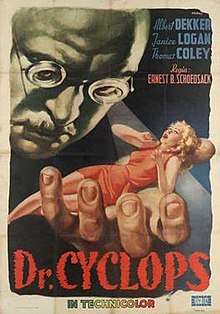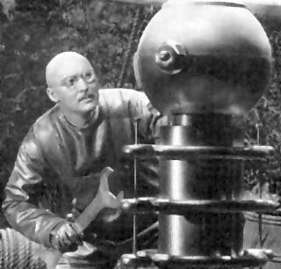Dr. Cyclops
Dr. Cyclops is a 1940 American Technicolor science fiction horror film from Paramount Pictures, produced by Dale Van Every and Merian C. Cooper, directed by Ernest B. Schoedsack, and starring Thomas Coley, Victor Kilian, Janice Logan, Charles Halton, Frank Yaconelli, and Albert Dekker.[1]
| Dr. Cyclops | |
|---|---|
 Theatrical release poster | |
| Directed by | Ernest B. Schoedsack |
| Produced by | Dale Van Every Merian C. Cooper |
| Written by | Tom Kilpatrick |
| Based on | "Dr. Cyclops" by Henry Kuttner |
| Starring | Albert Dekker Thomas Coley Janice Logan Charles Halton Victor Kilian |
| Music by | Gerard Carbonara Albert Hay Malotte Ernst Toch |
| Cinematography | Henry Sharp |
| Edited by | Ellsworth Hoagland |
Production company | Paramount Pictures |
| Distributed by | Paramount Pictures |
Release date |
|
Running time | 75 minutes |
| Country | United States |
| Language | English |
The film was nominated for an Oscar for Best Visual Effects by (Farciot Edouart and Gordon Jennings) at the 13th Academy Awards.[2]
Dr. Cyclops is based on a short story of the same name by fantasy and science fiction writer Henry Kuttner, which first appeared in the June 1940 issue of the pulp magazine Thrilling Wonder Stories.
Plot
Biologists Dr. Mary Robinson (Janice Logan) and Dr. Rupert Bulfinch (Charles Halton) are summoned by Dr. Alexander Thorkel (Albert Dekker) to his remote laboratory in the Peruvian jungle. They are accompanied by mineralogist Bill Stockton (Thomas Coley), a last minute substitute for another scientist (and who needs money to pay his IOUs), and Steve Baker (Victor Kilian), who wants to make sure his hired mules are well cared for (and suspects Thorkel may have discovered a rich mine). When they arrive, Thorkel asks the scientists to describe a specimen in his microscope, since his eyesight is too poor for him to do so himself. Bill identifies iron crystal contamination, much to Thorkel's satisfaction. Then, to their astonishment, Thorkel thanks them for their services and wants them to leave.
Insulted that they have traveled thousands of miles for nothing, they set up camp in Thorkel's stockade, insisting that he tell them more about his research. While snooping around, Steve discovers the area is rich with pitchblende, an ore of uranium and radium. When he finds them looking around his laboratory, Thorkel becomes angry, but as he is outnumbered, reveals he is shrinking living creatures, among them a horse, using radiation piped from a radium deposit down a deep shaft. He invites them and his assistant Pedro Caroz (Frank Yaconelli) to examine his apparatus, then locks them inside his radiation chamber. With the information that Bill has provided, he is able to correct the flaw that has killed his prior specimens. When his victims awaken, they find they have shrunk to twelve inches tall.[3]
They flee from Thorkel, and then from Thorkel's cat Satanus, from whom they are saved by Pedro's dog Tipo, who is bewildered by his master now being smaller than him. Bulfinch is eventually coaxed into speaking with Thorkel, but the latter is not interested in negotiating, merely in measuring Bulfinch. When he discovers that Bulfinch is growing, he realizes that the effect is only temporary. He murders Bulfinch in cold blood and sets out to hunt the others down so that they cannot go to the authorities.
The four survivors hack their way through gigantic jungle foliage and do battle with the wildlife. They attempt to launch Pedro's small boat (now enormous in their eyes), but are attacked by a caiman. When Thorkel locates them using Pedro's dog, Pedro leads Thorkel away from the others and is shot dead. The fugitives hide in one of Thorkel’s specimen cases and are brought back undetected to his lab.
While Thorkel goes outside to adjust a machine, Bill, Steve and Mary prepare to kill him with his own shotgun when he lies down on his bed. However, he instead falls asleep at his desk. They hide his spare glasses, then Steve steals the pair Thorkel put on his desk, managing to smash one lens before Thorkel awakes. Thorkel chases the shrunken trio to the mineshaft and precariously hangs by a rope when the plank he was lying on breaks. Steve cuts the rope, causing Thorkel to plunge to his death.
Months later, Bill, Steve and Mary return to civilization, restored to their original size. Bill and Mary are in love.
Cast

- Albert Dekker as Dr. Alexander Thorkel
- Thomas Coley as Bill Stockton
- Janice Logan as Dr. Mary Robinson
- Charles Halton as Dr. Rupert Bulfinch
- Victor Kilian as Steve Baker
- Frank Yaconelli as Pedro Caroz
- Paul Fix as Dr. Mendoza
- Frank Reicher as Professor Kendall
Production
Dr. Cyclops was directed by Ernest B. Schoedsack, responsible a few years earlier for King Kong. Like that film, Dr. Cyclops features elaborate sets and special effects. It is the first American horror film made in full, three-strip Technicolor; Doctor X (1932) and Mystery of the Wax Museum (1933) were made using the earlier two-color process. Schoedsack took special care to make certain that the color effects were believable.[4]
Reception
Critical response
Time Out London gave the film a mostly positive review, calling it "An engaging fantasy with brilliantly executed (though mostly rather unimaginative) special effects which look back to The Devil Doll and forward to The Incredible Shrinking Man. Let down by a dull supporting cast, but retrieved by the attractively pale, tremulous Technicolor."[5] Dennis Schwartz from Ozus' World Movie Reviews rated the film a grade B+, commending Dekker's performance while also noting that the film was "one of those bad films that is good because it's so much fun, and its noteworthy trick photography is effectively used for its dazzling special effects--way before the use of CGI".[6]
Variety gave the film a negative review, calling the film "dull" and criticizing the film's direction, story, and jumbled ideas.[7] TV Guide awarded the film a mixed two out of four stars, noting the film's "novel" special effects, but felt that the film 'wasted the opportunity to explore its subject'.[8]
Film historian John Brosnan has written of Dr. Cyclops: "It's a fast-paced, inventive film though the dialogue is awful and the acting is undistinguished with the exception of Albert Dekker's portrayal of Dr Thorkel. As with Charles Laughton's version of Dr. Moreau, his evil is not a byproduct of scientific zeal but a deliberate choice of action. The special effects deserve a mention, being ingeniously contrived and rather convincing, but the film is also noteworthy for its two unintentional references to the war that was about to engulf the world and end with the prospect of a nuclear apocalypse - Thorkel draws the power for his device from a 'radium mine' and, with his shaven head and thick, round glasses, he resembles the wartime caricature of the 'beastly Jap'".[9]
References
- This Month in Horror: April 1940
- "The 13th Academy Awards (1941) Nominees and Winners". oscars.org. Retrieved 2013-06-18.
- Rovin, Jeff (1987). The Encyclopedia of Supervillains. New York: Facts on File. pp. 87–88. ISBN 0-8160-1356-X.
- http://www.tcm.com/this-month/article/145282%7C0/Dr-Cyclops.html
- "Dr Cyclops, directed by Ernest B Schoedsack". TimeOut.com. Time Out Staff. Retrieved 6 June 2019.
- Schwartz, Dennis. "drcyclops". Sover.net. Dennis Schwartz. Retrieved 6 June 2019.
- "Dr. Cyclops – Variety". Variety.com. Variety Staff. Retrieved 6 June 2019.
- "Dr. Cyclops - Movie Reviews and Movie Ratings". TV Guide.com. TV Guide Staff. Retrieved 6 June 2019.
- John Brosnan. The Primal Screen: A History of Science Fiction Film. UK: Orbit Books, 1991, p. 30.
External links
| Wikimedia Commons has media related to Dr. Cyclops. |
| Wikiquote has quotations related to: Dr. Cyclops |